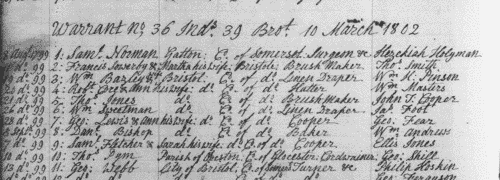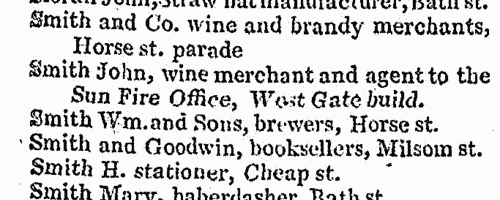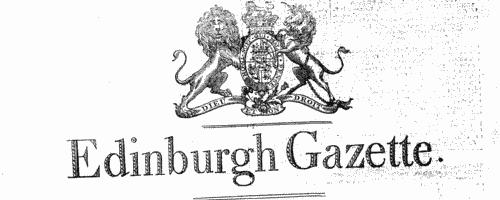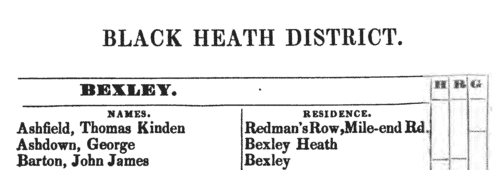Add this eBook to your basket to receive access to all 74 records. Our indexes include entries for the spelling kipping. In the period you have requested, we have the following 74 records (displaying 31 to 40): These sample scans are from the original record. You will get scans of the full pages or articles where the surname you searched for has been found. Your web browser may prevent the sample windows from opening; in this case please change your browser settings to allow pop-up windows from this site. Inhabitants of Brighton in Sussex
(1790-1797)
The provincial sections of the Universal British Directory include lists of gentry and traders from each town and the surrounding countryside, with names of local surgeons, lawyers, postmasters, carriers, &c. (the sample scan here is from the section for Bath). The directory started publication in 1791, but was not completed for some years, and the provincial lists, sent in by local agents, can date back as early as 1790 and as late as 1797.
| Sample scan, click to enlarge

|  Sailors on board H. M. S. Goliath
(1795-1798) Sailors on board H. M. S. Goliath
(1795-1798)
His Majesty's ship the Goliath took part in the destruction of the French fleet in Aboukir Bay at the mouth of the Nile ('the Battle of the Nile') on the evening of the 1st and morning of the 2nd August 1798. This is the muster book for 1 April to 30 September 1798: being a continuation book in a series covering wages and victualling from December 1795, it also includes the names of some men who had died, deserted or been discharged from the ship from then to April 1798. Of the ship's complement of 590, this index covers the sailors, volunteers, and boys, as well as the supernumeraries: but not the marines, or the French prisoners taken after the battle. | Sample scan, click to enlarge

|  Apprentices and clerks
(1798) Apprentices and clerks
(1798)
Apprenticeship indentures and clerks' articles were subject to a 6d or 12d per pound stamp duty: the registers of the payments usually give the master's trade, address, and occupation, and the apprentice's name, as well as details of the date and length of the apprenticeship. 2 January to 31 December 1798. IR 1/37 | Sample scan, click to enlarge

|  Masters of apprentices registered in West Kent
(1800) Masters of apprentices registered in West Kent
(1800)
Apprenticeship indentures and clerks' articles were subject to a 6d or 12d per pound stamp duty: the registers of the payments usually give the master's trade, address, and occupation, and the apprentice's name, as well as details of the date and length of the apprenticeship. There are central registers for collections of the stamp duty in London, as well as returns from collectors in the provinces. These collectors generally received duty just from their own county, but sometimes from further afield. The indentures themselves can date from a year or two earlier than this return. (The sample entry shown on this scan is taken from a Bristol return. Each entry has two scans, the other being the facing page with the details of the indenture, length of service, and payment of duty.) IR 1/69 | Sample scan, click to enlarge

| Subscribers to Thomas Sanderson's Original Poems: Tunbridge
(1800)
Thomas Sanderson's 'Original Poems' was published in Carlisle in 1800. The list of subscribers is arranged geographically: London; Tunbridge; Gloucester; Epsom; Exeter; Nottingham; Northampton; Cambridge; Oxford; Hertford; Carlisle; Penrith; Longtown; Hesket Newmarket; Wigton; Keswick; Durham; Newcastle; Maryport; Dublin; Edinburgh; York; and Liverpool, each including surrounding areas; Madras; and the West Indies. Where more than one copy was ordered, the number is given after the subscriber's name. At the foot of the list is this note: 'The Author cannot take leave of his friends without warmly thanking them for the generous encouragement they have given to the subscription. Their benevolence does them the more honour, as it was called forth in the favour of a Person who cannot make them any better return than mere professions of gratitude.' | Sample scan, click to enlarge

|  Apprentices and clerks
(1801) Apprentices and clerks
(1801)
Apprenticeship indentures and clerks' articles were subject to a 6d or 12d per pound stamp duty: the registers of the payments usually give the master's trade, address, and occupation, and the apprentice's name, as well as details of the date and length of the apprenticeship. 2 January to 31 December 1801. IR 1/38 | Sample scan, click to enlarge

|  Masters of apprentices registered in West Kent
(1802) Masters of apprentices registered in West Kent
(1802)
Apprenticeship indentures and clerks' articles were subject to a 6d or 12d per pound stamp duty: the registers of the payments usually give the master's trade, address, and occupation, and the apprentice's name, as well as details of the date and length of the apprenticeship. There are central registers for collections of the stamp duty in London, as well as returns from collectors in the provinces. These collectors generally received duty just from their own county, but sometimes from further afield. The indentures themselves can date from a year or two earlier than this return. (The sample entry shown on this scan is taken from a Bristol return. Each entry has two scans, the other being the facing page with the details of the indenture, length of service, and payment of duty.) IR 1/70 | Sample scan, click to enlarge

| Inhabitants of Maidstone, in Kent
(1805)
Holden's Triennial Directory of 1805 to 1807 included a provincial section, listing professional people and traders in England, Wales, Scotland and Ireland. (The sample scan here is from the listing for Bath) | Sample scan, click to enlarge

| Officers of the 4th (King's Own) Regiment of Foot
(1820)
The War Office issued regular notices of promotions and appointments within the British Army, and these were published in the Edinburgh Gazette. Full names of these officers are given, as well as the surnames of those whose places they filled because of promotion, resignation, death, dismissal or exchange. January to December 1820. | Sample scan, click to enlarge

| Electors in East Peckham
(1835)
A poll to elect knights of the shire to represent the Western Division of the county of Kent in parliament was held in 1835, the candidates being Thomas Law Hodges (H), Thomas Rider (R) and sir William R. P. Geary (G). The poll started on January 19th; Rider withdrawing his name on that first day, the poll was closed prematurely, many electors not yet having voted. This poll book lists all the electors, whether they voted or not; the county franchise included not only male freeholders of 40s a year, but also £10 copyholders and long-leaseholders, and £50 short-leaseholders and tenants. For each elector the full name is given (surname first) and residence (often not the place for which qualified to vote). Votes are indicated by dashes in the right-hand columns. | Sample scan, click to enlarge

|
Research your ancestry, family history, genealogy and one-name study by direct access to original records and archives indexed by surname.
|












